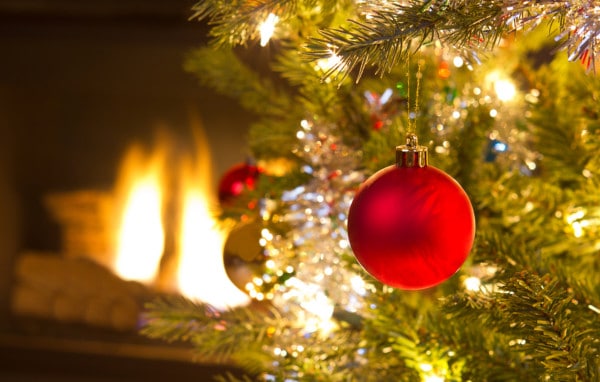Protect your home from electrical, candle, cooking, and Christmas tree fires with these holiday fire safety tips
‘Tis the season for festive family gatherings, twinkling holiday decorations, and gifts galore. But looming dangers like dried-out Christmas trees, holiday meals left unattended on the stove, tipped Hanukkah candles, and more can transform the holiday season into a dangerous time of year.
The American Red Cross reports that house fires spike in the winter months, peaking in December and January. And the U.S. Fire Administration reports that the number of fires on Christmas day sparked by items with open flames is more than double the usual average.
Fatalities are also 70 percent higher than average during holiday fires and property loss is 34 percent greater.
So, rush down the stairs, grab a coffee, and rip off the wrapping on QRFS’s gift: holiday fire safety tips to keep the season happy, bright, and fire-safe.
Looking for home fire protection? Browse our online selection of residential fire sprinklers, fire extinguishers, or other equipment that protects lives and property from fire. Class K fire extinguishers and fire blankets are available via special order. Call us at +1 (888) 361-6661 or email support@qrfs.com.
O Christmas tree: while rare, Christmas tree fires are more likely to cause deaths than other fires
In January 2015, a tragic Christmas tree fire spread so fast in an Annapolis, MD, mansion that two grandparents and their six young grandchildren had no time to escape—despite their smoke alarm’s warning. Wiring beneath the 15-foot Christmas tree sparked the blaze and the dried-out tree fueled the flames, enabling the fire to engulf the house within minutes.
The tree had been up for nine weeks and only watered weekly. The lights were left on continuously. NBC News reports that controlled burns conducted by the Bureau of Alcohol, Tobacco, Firearms, and Explosives found that a tree watered daily took seven minutes to ignite a dangerous fire. A tree watered weekly erupted into dangerous flames in 30 seconds.
Sadly, the family had planned to remove the tree the day after the fire.
Dehydrated trees with malfunctioning lights are a recipe for disaster. A large, dry, burning tree doesn’t take long to spread fire throughout a house, putting everyone in danger.
The National Fire Protection Association (NFPA) states that although Christmas tree fires represent less than 1% of all residential fires, they’re much more likely to end with tragic results. On average, one out of every 52 home fires between 2013 and 2017 that started with a Christmas tree resulted in a death, compared to an average of one death per 135 total reported home fires.
Watch this video for a visual representation of why you should water your Christmas tree:
Here are some ways to minimize the risk of holiday trees going up in flames:
Holiday fire safety tips to prevent Christmas tree fires
- Make sure the tree is fresh when you purchase it, with soft, flexible, green needles that don’t fall off when you touch it or shake it gently. Before placing the tree in the stand, cut another 2 inches off the trunk to encourage the tree to drink.
- Water your tree daily; its base should be constantly submerged. Fresh trees dry out quickly in heated homes—two or three days without water can be enough to dry one out. Of course, no matter how well you water it, your tree will turn dry and brittle after four weeks. Take it down after the holidays.
- Avoid carving off the sides of the trunk to fit a tree stand. The outer layers of wood are most efficient at taking in water.
- Always keep your tree at least three feet from any heat source, such as a fireplace, radiator, lit candle, or lights. NFPA’s “Christmas Tree Safety” tips state that a heat source too close to the tree leads to one in four tree fires.
- Make sure the tree isn’t blocking an exit.
- Get rid of the tree after Christmas or when it’s dry. And keep this in mind: dried-out trees remain a fire danger if they are placed anywhere else in the home or garage, or outside against the house.
- You can also use artificial trees that are flame-retardant.
Holiday fire safety tips for tree lights
- Only use lights sporting a label from a recognized testing laboratory, like UL. Use lights that specify indoor or outdoor use appropriately.
- Inspect lights carefully before plugging them in. Replace any string with worn or broken cords or loose bulb connections. Read the manufacturer’s instructions to determine the number of light strands that are safe to connect.
- Never use lit candles to decorate a tree.
- Always turn tree lights off before leaving home or going to bed.
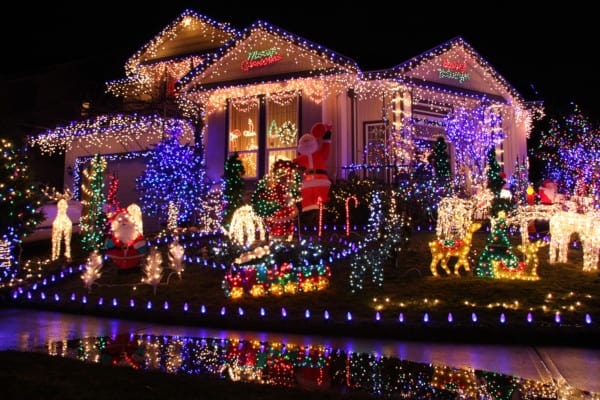
Holiday fire safety requires proper use of Christmas lights
Few things set a festive mood better than twinkling strings of lights brightening a home on a wintry night. But the NFPA reports that one in four holiday fires is caused by electrical problems.
Many people overload electrical circuits to accommodate holiday lighting, decorations, and cooking appliances—increasing the potential for electrical fires and outages. However, fires sparked by holiday decorations are highly preventable if the right safety precautions are taken. So, before you go all Clark Griswold about decorating this year, take a minute to read these safety tips:
- Inspect electrical and battery-operated lights before use and discard any that are damaged. Frayed or cracked electrical cords or broken sockets are major fire hazards during the holidays.
- Inspect extension cords you plan to use before plugging them in to ensure they are in good condition. Pay attention to whether they are rated for indoor or outdoor use. Never string multiple extension cords together.
- Follow packaging directions for decorative light strings. Lights are typically labeled for either indoor or outdoor use, but not both. Do not string together more sets of lights than the product’s instructions recommend.
- Use UL-rated clips or hangers to hang lights outside. Nails or staples can damage the wiring and increase the risk of fire. Also be careful not to pinch or bend electrical cords, force them into small spaces, or place them where they’re likely to get stepped on or tripped over.
- Never (ever!) overload a circuit. The average household circuit can power 70 strings of 50-bulb mini lights or between 300 and 600 strings of LED lights. If you need to use more, spread the light strands across multiple circuits to prevent an overload. Take any major appliances into account before plugging lights into the same circuit. Click here to learn how to calculate the number of lights that can safely plug into the average home circuit.
- Just like the tree, turn off all other lights and decorations before going to bed. Installing a timer on outside lights eliminates the chance that they remain on all night because you fell asleep or didn’t want to brave the cold at bedtime to turn them off.
- Use a ground-fault circuit interrupter (GFCI) in places where water and electricity can potentially mix, causing a dangerous reaction. GFCIs monitor the electrical current flowing through them and automatically shut off if the current becomes unbalanced, such as when water enters a system. Your outlet is a GFCI if it has a “test” and “reset” button.
- Bring outdoor electrical lights inside after the holidays. Lights can be chewed on by squirrels or damaged by weather. Taking them down not only helps prevent hazards, but it also helps lights last longer.
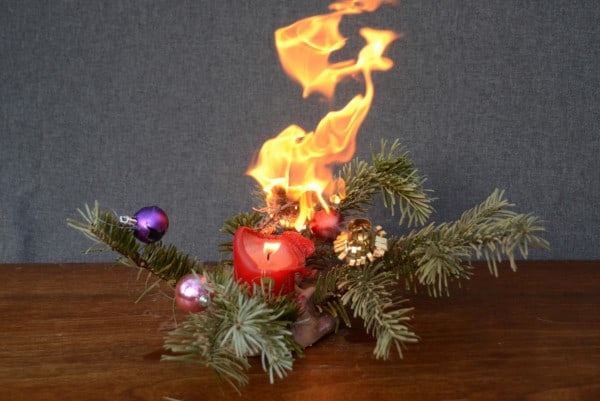
Make your holiday merry and bright—but safe from candle fires
Whether they hold religious meaning or simply set a holiday mood with the wafting smell of pine, cinnamon, or cranberry, candles can be an essential part of holiday decorations. But NFPA reports that candles started an estimated 8,200 home structure fires every year between 2012 and 2016, causing an annual average of 80 deaths, 770 injuries, and $264 million in direct property damage.
Not surprisingly, December is the peak time of year for home candle fires—and the top three days are Christmas, New Year’s Eve, and New Year’s Day, NFPA reports. Nearly 60% of December home decoration fires are started by candles, compared to 32% the rest of the year.
Follow these tips for staying fire smart when you deck the halls with candles and other holiday decorations this season:
- Only use decorations that are flame resistant or flame retardant.
- The U.S. Fire Administration reports that nearly half of holiday decoration fires spark because flammable objects were placed too close to a heat source. Keep lit candles at least 12 inches away from decorations and other things that can burn.
- Keep lit candles in stable holders and place them where they can’t be knocked over easily.
- Always blow out lit candles before leaving a room or going to bed.
- Keep children and pets away from lighted candles. Keep matches and lighters up high in a locked cabinet as well; during the winter holiday season, an average of 40 home fires per day are caused by children playing, according to the American Red Cross.
- Consider using battery-operated flameless candles which can look, smell, and feel like real candles without the risk of fire.
- Don’t burn Christmas tree branches or wrapping paper in fireplaces. The ink in wrapping paper can give off toxic fumes when burned. Dry evergreens are loaded with resin that burns very quickly and “pops,” producing embers that can rise through the chimney and trigger a chimney fire.
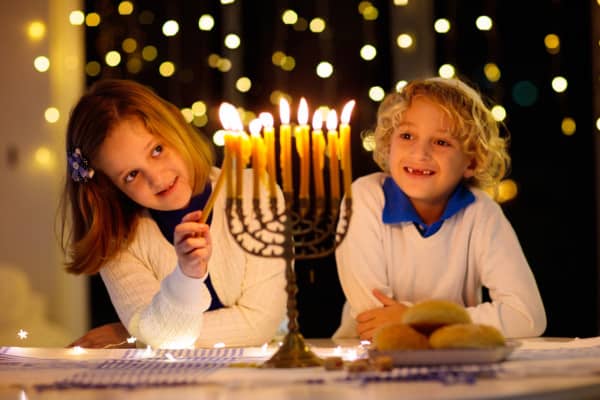
Cooking ranks as the leading cause of home fires and injuries
No holiday tradition is complete without a festive meal. But NFPA states that cooking fires—not electrical problems, trees, or candles—are the number one cause of home fires and injuries. And after Thanksgiving, the largest number of cooking fires occurs on Christmas Day and Christmas Eve.
Watch this NFPA video to learn more about home cooking safety. And read on for tips on safe holiday entertaining:
For cooking fire safety:
- Stay in the kitchen while frying, grilling, boiling, or broiling food. NFPA reports that unattended equipment is a factor in one-third of reported home cooking fires and half of the associated deaths.
- Stay alert while cooking. If you’re feeling sleepy or have consumed alcohol, refrain from using the stove or stovetop.
- Check food that is simmering, baking, or roasting regularly, and remain in the kitchen while it’s cooking. With so many distractions in the house during the holidays, it’s wise to use a timer to remind you that you’re cooking.
- Keep anything that can catch fire away from the stovetop. That includes oven mitts, wooden utensils, food packaging, towels, curtains, and wide sleeves on your clothes.
- Keep a lid nearby when you’re cooking to smother small grease or oil fires. Smother the fire by sliding the lid over the pan and turning off the stovetop. Leave the pan covered until is completely cooled. NFPA warns to never throw water on an oil fire, which can cause the oil to splash and spread the fire even worse. Fire blankets are also great at containing cooking fires, especially ones that are too big to handle with a lid.
- For oven fires, turn off the heat and keep the door closed.
- If the fire isn’t small or spreads beyond the pot or pan, get out and make sure others are getting out. Close the door behind you to help contain the fire and call 9-1-1 or the local emergency number from outside. And read this carefully: Never try to fight even a small fire without making sure others are evacuating and you have a clear way out.
- When cooking with oil, heat the oil slowly to the temperature you need for frying or sautéing. Add food gently to the pot or pan so the oil doesn’t splatter. If you see wisps of smoke or the oil smells, turn off the burner and/or carefully remove the pan from the burner. Smoke is a warning that the oil is too hot.
- Keep a fire extinguisher in the kitchen that’s capable of putting out grease fires (Class K). Make sure you know how to use it.
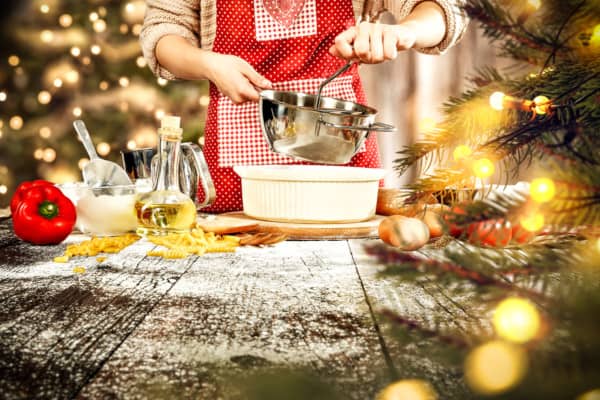
For general home entertaining fire safety:
- Test your smoke alarms. With the increased risk of fire during the holidays, it’s essential to have working smoke alarms installed throughout a home. Test smoke detectors at least monthly and replace alarm batteries regularly. NFPA provides important information on smoke alarm requirements, testing, and more.
- Familiarize guests with your home fire escape plan. The synthetic materials used in modern homes make fires burn faster and hotter than ever before, leaving people as little as two minutes before it’s too late to escape.
- Ask smokers to smoke outside. Remind them to keep their smoking materials with them so young kids aren’t tempted to touch them.
- Provide large, deep ashtrays for smokers. Wet cigarette butts before discarding.
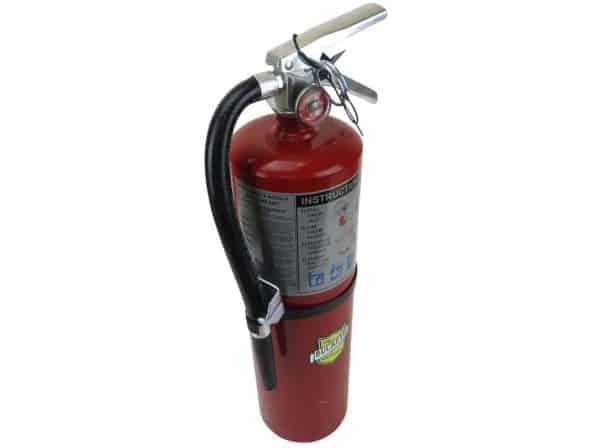
Holiday fire safety: Deck the halls safely this season
Crooner Andy Williams knew what he was talking about when he dubbed December “the most wonderful time of the year.” But it also marks an increase in preventable home fires. Keep your home and loved ones safe by following our fire safety tips. And rest assured that holiday wishes are the warmest thing to engulf your home this season.
The QRFS team wishes you the happiest of holidays and peace, love, and joy in the new year!
QRFS is dedicated to fire safety. Browse our online selection of residential fire sprinklers, fire extinguishers, or other equipment that protects lives and property from fire. Class K fire extinguishers and fire blankets are available via special order. Call us at +1 (888) 361-6661 or email support@qrfs.com.
This blog was originally posted at blog.qrfs.com. Check us out at Facebook.com/QuickResponseFireSupply or on Twitter @QuickResponseFS.


